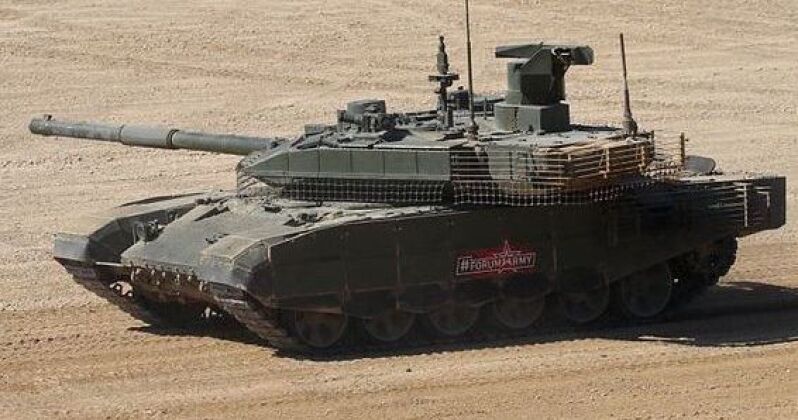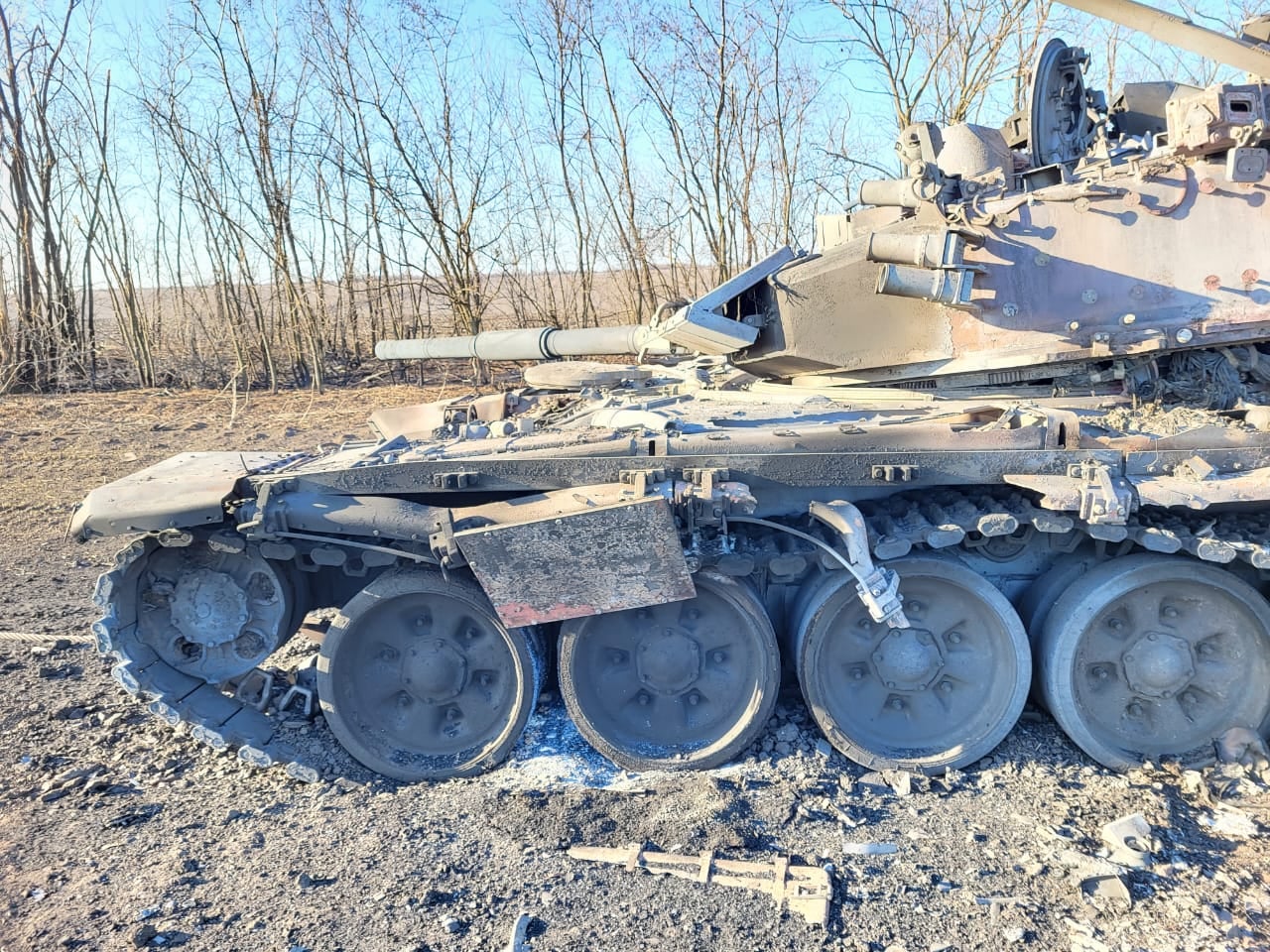The T-90 main battle tanks (MBTs) are the most advanced Russian tanks currently in the thick of combat against Ukraine. The T-90s are often compared with advanced Western tanks like the M1 Abrams, Challenger-2, and Leopard-2 MBTs.
So far, the Russian military has suffered 61 documented losses of the T-90 tanks, according to the figures compiled by the military tracking blog Oryx based on visual confirmations.
Of these, 18 are the advanced T-90M variant, available in very limited numbers. As far back as last May, the Russian army was said to have as few as 100 T-90M tanks.
That said, the latest batch of an unspecified number of T-90 tanks was delivered to the Russian Ministry of Defense (MoD) by the state-owned Uralvagonzavod (UVZ) in December 2022. These tanks were allocated to Russia’s Central Military District, whose units are involved in the fighting in Ukraine.
Before that, Uralvagonzavod had reportedly delivered a batch of newly-built T-90Ms and some old tanks that were upgraded to this level in May 2022.
T-90M Main Battle Tank
The T-90 is a third-generation main battle tank with a welded composite armor hull and built-in Kontakt-5 explosive reactive armor blocks.
However, the upgraded T-90M variant has improved armor protection with Relikt built-in Explosive Reactive Armor (ERA) in place of the previous Kontakt-5, designed to protect shaped charges and significantly reduce the impact of the armor-piercing fin-stabilized discarding sabot (APFSDS) rounds.
In addition, the tank features net armor on the lower part of its turret and slat armor at its rear to improve defenses against rocket-propelled grenades by disrupting the fusing of the warhead.

The tank also has a countermeasures system, which triggers smoke grenade launchers that can help conceal the vehicle if illuminated by a laser beam, thereby minimizing the chance of being hit by enemy anti-tank-guided weapons with semi-automatic guidance.
Notably, the smaller size and low profile of the T-90 reportedly allow it to navigate tight spaces such as forests and mountains, thereby enabling it to entrench itself.
The T-90 is said to have a top speed of about 59 kilometers on-road and 45 kilometers per hour off-road.
As for the armament, most of the T-90s are A variants that are armed with a fully-stabilized 2A46M 125mm smoothbore gun, capable of firing armor-piercing fin-stabilized discarding-sabot (APFSDS), high-explosive (HE), and high-explosive-fragmentation (HE-FRAG) rounds up to a range of around 2-3 kilometers during the day and 2-2.6 kilometers at night time.
However, the T-90M boasts an improved 2A46M-4 125mm smoothbore main gun, which has a more extended range of 4-5 kilometers and is said to be 15-20% more accurate than the standard 2A46M gun.
Interestingly, the T-90M captured in September last year by Ukrainian force was found outfitted with Nakidka radar-absorbent material (RAM), which is said to reduce the vehicle’s infrared, thermal, and radar signatures, and is meant to defend the tank against guided weapons reliant on thermal imaging to lock onto a target.
Furthermore, according to some reports, the T-90s are also equipped with a ‘TShu-1-7-Shtora-1’ optronic system to disrupt laser designation and rangefinders of incoming anti-tank guided missiles (ATGMs) and an electro-optical jammer to jam the enemy’s semi-active command to line of sight (SACLOS) guidance used for ATGMs.
The Shtora-1 also consists of a laser warning device mounted externally on the turret, which can detect laser illuminating and alert the crew and defensive systems to optimize the deployment of a thermal smoke screen or activation of active protection systems (APS). It can even reportedly automatically turn the turret and gun toward the threat.
However, the T-90s have not been the kind of game-changers for Russia in its ongoing conflict in Ukraine as they should have been, going by the technical details shared by Moscow.

Why T-90s Have Not Been Game-Changer?
To get an appropriate estimate of T-90’s efficacy, EurAsian Times consulted Lt. Colonel Nektarios Papantoniou of the Hellenic Army, who is also Greece’s national coordinator for the European program, Main Battle Tank Simulation and Testing Center (MBT-SIMTEC).
Papantoniou began by explaining that the common belief among tank users is that the performance of any means of comparable technology relies heavily on the quality of the training of their crews.
He then pointed out that most of the action in Ukraine occurs in urban areas and not open fields. The urban areas do not influence the tank’s cross-country maneuvering and long-range engagement capabilities.
As a result, Papantoniou continued, “Mechanized and combined arms tactics, in general, are much more important than the individual characteristics of any single weapon system. The T-90/M performance might not be what one might expect, but I highly doubt that this is the sole outcome of the tank’s capabilities.”
Despite the T-90s having a Shtora-1 system, videos on social media have emerged showing the destruction of Russian tanks by anti-tank missiles fired from elevated positions “top-down” onto vehicles in Ukraine, which suggests that Russian tanks do not have a 360-degree active protection system (APS).
#Ukraine: A Russian tank, presumably a T-90M, was taken out of action by the Ukrainian 66th Mechanized Brigade in #Luhansk Oblast.
Another abandoned armoured vehicle can be seen nearby. pic.twitter.com/UECzRzEYQ5
— ?? Ukraine Weapons Tracker (@UAWeapons) April 3, 2023
When asked about this, Papantoniou said that the Shtora-1 system was designed more than 30 years ago to effectively protect against SACLOS (Semi-Automatic-Command-to-Line-of-Sight) ATGMs and weapons employing LASER rangefinders and designators.
“As such, it seems to be effective against older types of ATGMs that operated in “straight lines” (meaning that the user/launcher, the missile, and the target were parts of the same straight line), but much less against newer threats, such as top attack missiles and sub-munitions and systems using encoded tracking beacons,” he noted.
Furthermore, Papantoniou explained that the Shtora sensors have specific capabilities like the height and width of the areas of detection are of specific dimensions, “as such, newer generation ATGMs fired from elevated positions, per your questions, bear a significantly higher possibility to have a lethal effect upon a target, since they will most probably maneuver well outside the area monitored by the Shtora sensors.”

He also noted that the terrain and operational conditions could also severely affect the capabilities of the land warfare systems, and it is, therefore, up to the crews to use their equipment according to the terrain operating in such a way as to minimize the deficiencies of any system and make the most out of its capabilities.
“Needless to say, poor quality training can rarely be counterbalanced by hardware, no matter how advanced the technology integrated,” Papantoniou said.
For anyone who is unfamiliar with T-90 series, note these two boxes called Shtora-1 dazzlers, and their purpose is to disrupt incoming ATGMs laser guidance systems. They are found on T-90As used in Ukraine by Russia along with only T-80 variant. pic.twitter.com/7ZTYhBNAwJ
— Hovhannes (@JughaFedayi) April 7, 2022
When asked about the losses of T-90s, Papantoniou said that the T-90 is derivative of the older T-72 and bears many of the T-72’s design flaws while simultaneously incorporating the ideas of how this upgraded and improved design would be used against NATO adversaries during a potential Cold War-era conflict.
However, Ukraine presents a very different type of threat environment where most of the action is taking place in urban or semi-urban areas of the country. The mechanized units are also facing some new generation threats like loitering munitions such as Switchblade and Lancet, which most of the current land systems are not adequately effective against.
He then reiterated his point about the training of the crews, saying that “the events on the field do not paint a very good image of the quality of the Russian tank crews – be it either due to their training or tactics.”
“To sum it up, I would say that said losses are perfectly normal within the “perfect storm” created by four distinct factors; the design and capabilities of the equipment used, the quality of the tank crews, the numerous new generation threats, and the tactics implemented,” Papantoniou said in the end.
- Contact the author at tanmaykadam700@gmail.com
- Follow EurAsian Times on Google News




